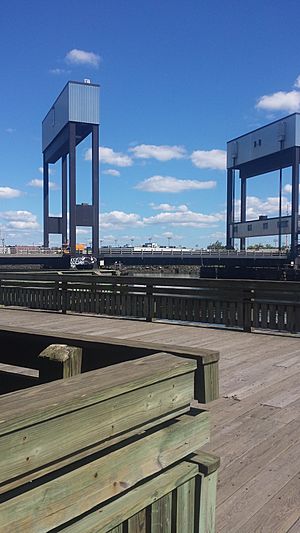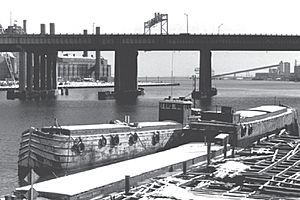Berkshire No. 7 facts for kids

Site of the sunken Berkshire No. 7
|
|
| History | |
|---|---|
| Owner | Steward J. Dailey |
| Operator | S. J. Dailey Company |
| Route | Connecticut–Long Island Sound |
| Ordered | 1935 |
| Builder | Jacobson and Peterson, Inc. |
| Completed | 1935 |
| Out of service | 1974 |
| Fate | Sunk in 1974 |
| General characteristics | |
| Type | Canal barge |
| Tonnage | 216 |
| Length | 104 feet (32 m) |
| Beam | 20 feet (6.1 m) |
| Depth of hold | 10 feet (3.0 m) |
|
Berkshire No. 7
|
|
| Location | Bridgeport Harbor, Bridgeport, Connecticut |
| Area | less than one acre |
| Built | 1935 |
| Architect | Jacobson, Irving |
| NRHP reference No. | 78002837 |
| Added to NRHP | December 21, 1978 |
The Berkshire No. 7 was a special type of boat called a barge, built in 1935. It was made from both wood and steel. This barge is important because it's a rare example of an old-style canal boat. It helped move heavy goods, like fertilizer, from Connecticut across the Long Island Sound. In 1974, the Berkshire No. 7 sank in Bridgeport, Connecticut harbor. It went down with two other barges, the Elmer S. Dailey and the Priscilla Dailey.
Today, the Berkshire No. 7 is still underwater. It has become very old and weak. Trying to pull it out of the water might cause it to break into pieces. Because of its history, the Berkshire No. 7 was added to the National Register of Historic Places on December 21, 1978. This means it's recognized as an important historical site.
What Was the Berkshire No. 7 Like?
The Berkshire No. 7 was a small barge built for canals. It was about 104 feet (32 m) long. That's longer than two school buses! It was also 20 feet (6.1 m) wide. The part of the boat that held cargo was 10 feet (3.0 m) deep. It could carry up to 216 tons of goods.
This barge was special because it mixed old and new building styles. It had a strong steel frame. But its outer skin was made of wood planks. This design made it a "transitional" canal barge. It had a mostly rectangular shape. The front was a bit rounded, and the back was squared off. A low wall, called a coaming, ran along the top. This wall had covers that protected the cargo. There was also a small cabin on top. The Berkshire No. 7 was officially listed as U.S. Registry #172071.
The Story of the Berkshire No. 7
The Berkshire No. 7 was built in 1935. It was made by a company called Jacobson and Peterson, Inc. in Brooklyn, New York. The barge was built for Stewart J. Dailey. He used to drive mules that pulled boats on the Erie Canal. Later, he started his own company, S. J. Dailey Company.
The Berkshire No. 7 was used to move materials. From 1941 to 1972, it carried things like fertilizer. It traveled from Connecticut to Long Island Sound. After 1972, the barge was docked in Bridgeport Harbor. It was tied up with two other barges, the Elmer S. Dailey and the Priscilla Dailey.
Then, in the spring of 1974, something unexpected happened. One of the barges started to fill with water. As it sank, it pulled the other two barges down with it. The Berkshire No. 7 has been underwater ever since. You can't see any part of it above the water today.
Why Is This Barge Important?
The Berkshire No. 7 is historically important because of how it was built. Its design shows how canal boats were made in the 1800s. Even though it looks like a canal boat, there's no record of it ever being used on a canal. It's one of only two wooden-hulled canal boats left today.
It was added to the National Register of Historic Places in 1978. This was unusual because the barge was less than 50 years old at the time. Also, it had already sunk! The Berkshire No. 7 and the two other barges that sank with it are the only shipwrecks in Connecticut listed on the National Register.
In 1998, the sunken barges became a topic of discussion. The Port Authority of Bridgeport Harbor was planning a big project. The sunken ships were in the way. Over the years, the barges had become very fragile. Trying to remove them might cause them to break apart.
By 2003, no action had been taken. However, a report suggested something important. Before anyone tried to move the Berkshire No. 7, it should be fully documented. This would include taking photos and writing a detailed description. These records would be kept at the State Historic Preservation Office and the Mystic Seaport Museum. This way, its history would be preserved, even if the barge itself couldn't be saved.




